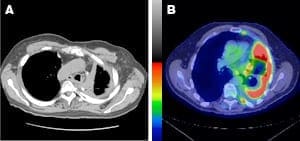
Diagnosing mesothelioma can be difficult because the symptoms of mesothelioma are similar to other conditions. The patient’s medical history must be reviewed, including any history of asbestos exposure. X-rays and a CT or CAT scan may be required. A CT scan is a series of pictures of areas inside the body. An MRI, or magnetic resonance imaging, is similar to a CT scan in that it takes detailed pictures of the inside of the body, but it does so by use of a magnet.
Diagnosis
As with other types of cancer, diagnosing malignant mesothelioma often requires a biopsy. To have a biopsy, a physician removes a sample of tissue to be studied under a microsope by a pathologist. Biopsies can be done in several ways, depending on where the suspected abnormal area is located. If the suspected mesothelioma is in the chest, either in the lungs or heart, a thoracoscopy is done. A thoracoscopy is performed by making a small cut in the chest and putting a lighted tube called a thoracoscope into the chest between the ribs. If the suspected mesothelioma is in the stomach, a peritoneoscopy is done. A peritoneoscopy is performed by cutting a small opening in the abdomen and using a peritoneoscope to get samples of the abnormal cells. The doctor may also wish for more extensive tests or diagnostic surgery.
Identifying and Staging
The next step in identifying malignant mesothelioma is staging. Staging involves more tests so the doctor can learn the exact stage of the disease and if the cancer has spread (metastasized) or remained in the same area of origination (localized).
Staging is based on a number of characteristics of the disease. Those in use now consider three main aspects of the disease (the TNM system):
- T: primary tumor and the extent of its spread (no spread / local spread only / more distant but direct spread)
- N: involvement of lymph nodes (nil / spread to nodes on the same side of the chest / spread to more nodes in the other side of the chest or more distantly)
- M: whether there are metastases (distant spread of tumor via blood or lymph, not by direct extension)
Staging is commonly expressed from I (early disease, localized disease) to IV (widespread tumor, with involvement of lymph nodes and metastases).
Go to Asbestos-Mesothelioma Case Evaluation Form >>
Read more at Mesothelioma & Asbestos-related Diseases Overview >>